Tete-Beche: János Hunyadi (1385-1456) military leader; statue (Hungary 1956)
János Hunyadi (1385-1456) military leader; statue (Hungary 1956)
12 August (Hungary ) within release János Hunyadi goes into circulation Tete-Beche János Hunyadi (1385-1456) military leader; statue face value 2*1 Hungarian forint
| Tete-Beche János Hunyadi (1385-1456) military leader; statue in catalogues | |
|---|---|
| Philatelia Hungarica Catalog: | PHu: HU 1530aXIIIB |
Tete-Beche is horizontal format.
Together head to tail in the perforated in the middle.Also in the issue János Hunyadi:
- Se-tenant - János Hunyadi face value 2*1;
- Stamp - János Hunyadi (1385-1456) military leader; statue face value 1;
- Tete-Beche - János Hunyadi (1385-1456) military leader; statue face value 2*1;
- Stamp - János Hunyadi (1385-1456) military leader; statue face value 1;
Tete-Beche János Hunyadi (1385-1456) military leader; statue it reflects the thematic directions:
A general officer is an officer of high rank in the armies, and in some nations' air and space forces, marines or naval infantry
The horse (Equus ferus caballus) is one of two extant subspecies of Equus ferus. It is an odd-toed ungulate mammal belonging to the taxonomic family Equidae. The horse has evolved over the past 45 to 55 million years from a small multi-toed creature, Eohippus, into the large, single-toed animal of today. Humans began to domesticate horses around 4000 BC, and their domestication is believed to have been widespread by 3000 BC. Horses in the subspecies caballus are domesticated, although some domesticated populations live in the wild as feral horses. These feral populations are not true wild horses, as this term is used to describe horses that have never been domesticated, such as the endangered Przewalski's horse, a separate subspecies, and the only remaining true wild horse. There is an extensive, specialized vocabulary used to describe equine-related concepts, covering everything from anatomy to life stages, size, colors, markings, breeds, locomotion, and behavior.
A monument is a type of structure that was explicitly created to commemorate a person or event, or which has become relevant to a social group as a part of their remembrance of historic times or cultural heritage, due to its artistic, historical, political, technical or architectural importance. Examples of monuments include statues, (war) memorials, historical buildings, archaeological sites, and cultural assets. If there is a public interest in its preservation, a monument can for example be listed as a UNESCO World Heritage Site. The Palgrave Encyclopedia of Cultural Heritage and Conflict gives the next definition of monument:
Sculpture is the branch of the visual arts that operates in three dimensions. Sculpture is the three-dimensional art work which is physically presented in the dimensions of height, width and depth. It is one of the plastic arts. Durable sculptural processes originally used carving (the removal of material) and modelling (the addition of material, as clay), in stone, metal, ceramics, wood and other materials but, since Modernism, there has been almost complete freedom of materials and process. A wide variety of materials may be worked by removal such as carving, assembled by welding or modelling, or moulded or cast.
A statue is a free-standing sculpture in which the realistic, full-length figures of persons or animals are carved or cast in a durable material such as wood, metal or stone. Typical statues are life-sized or close to life-size. A sculpture that represents persons or animals in full figure, but that is small enough to lift and carry is a statuette or figurine, whilst those that are more than twice life-size are regarded as colossal statues.




